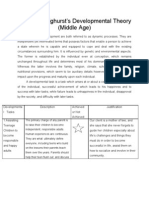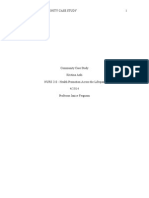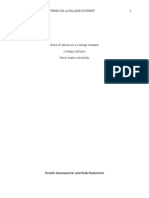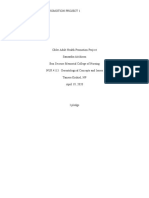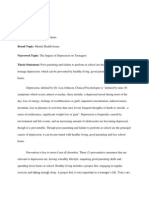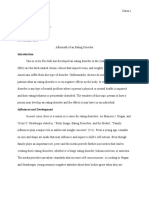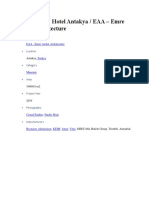Cuthbert Aging Paper
Cuthbert Aging Paper
Uploaded by
shawnee11Copyright:
Available Formats
Cuthbert Aging Paper
Cuthbert Aging Paper
Uploaded by
shawnee11Original Description:
Copyright
Available Formats
Share this document
Did you find this document useful?
Is this content inappropriate?
Copyright:
Available Formats
Cuthbert Aging Paper
Cuthbert Aging Paper
Uploaded by
shawnee11Copyright:
Available Formats
Running head: AGING PAPER
Aging Paper
18944 Shawnee Cuthbert
Cedar Crest College
AGING PAPER
2
Abstract
The purpose of this paper is to explore the aging process using appropriate evaluation tools. The
assessments discussed include activities of daily living (ADLs), instrumental activities of daily
living (IADLs), sensory (including hearing, eyesight, and speech), economics, spirituality, living
at home and social support, medical history, and areas of mental health. Two main problem areas
are examined, and two nursing diagnoses for each are identified and discussed. Interventions and
rationales are provided for each identified nursing diagnosis. As a person ages, many different
problems can arise and overcoming these events can be difficult. Whether the changes are
normal, or a new onset of a disease process, many older adults find it difficult to cope positively
with these changes. Through the assessments, it is hoped that we learn from a person over age 65
and understand the struggles of aging and identify problem areas to improved positive coping.
Keywords: Aging adults, assessments for the elderly, coping mechanisms in aging,
instrumental activities of daily living, activities of daily living, spirituality, fall risk, independent
living, depression in older adults.
AGING PAPER
3
Aging paper
Aging causes many changes and some of these changes can cause adverse outcomes.
These changes, in regards to mental status, general health and mobility, can affect the overall
condition of the elderly population. Personal losses due to death and disability lead to limited or
non-existent social support. This paper examines a 79 year old male who has experienced a
decline in health, limited mobility as he ages, and loss of social support. Additionally, this paper
will address the manner in which he is coping with the aging process.
The client discussed, C.S., has a history of diabetes mellitus, bilateral hip replacement,
hypertension, hyperlipidemia, and falls, including one in the last year. Diagnosed at age 44 with
DM, the client manages the disease closely. This is evidenced by having no diabetic ulcers,
controlled blood glucose levels, and an HA1C of 7.5%. The client self-administers injections of
Novolog 70/30, BiD. For other medical issues, C.S. takes Enalapril 20 milligrams and
furosemide 25 milligrams, both twice a day for hypertension, and Lovastatin 10 milligrams once
a day to control hyperlipidemia.
Health Assessments
Activities of Daily Living
C.S. can perform all ADLs on his own, including dressing, bathing, dental care, and
toileting. His house is free of clutter and is small enough that everything needed is within a few
paces. C.S. shops, cooks and cleans on his own. The Katz Index of Independence in activities of
Daily Living assessment was performed (Katz, Ford, Moskowitz, Jackson & Jaffe, 1963;
Appendix A) and C.S. scored 6/6 on this assessment. The result is the highest score and is
consistent with C.S. who is independent and manages ADLs very well. These results confirmed
what this nurse observed and no need for further testing was required.
AGING PAPER
Instrumental Activities of Daily Living
To assess instrumental activities of daily living, C.S. was assessed using the Lawton
Instrumental Activities of Daily Living (IADL) Scale (Lawton & Brody, 1969; Appendix B). The
highest possible score is 8, which signifies independence and C.S. scored 6/8 which suggests he
is mostly independent. The areas in which C.S. scored zero were in the shopping and food
preparation areas. C.S. stated that he can do these things, if he really wanted, but prefers to eat
out for all meals so he doesnt shop too much and rarely cooks.
Communication
C.S. communicates verbally without difficulty and his speech is clear. According to C.S.,
he wears reading glasses and has restricted driving to daylight hours. This is not on medical
advice but C.S. states he cannot see when it gets dark. C.S.s hearing was assessed using the
Hearing Screening for Older Adults Test (Ventry, I & Weinstein, B., 1983; Appendix C). This
tool scores from 0-40, with 10-24 suggesting mild-moderate hearing handicap. C.S. scored a 24,
which is the highest score possible in the moderate hearing handicap level. C.S. does not
currently use hearing aids but does admit he knows he needs one. C.S. reports that the hearing
loss mildly affects his social interactions but not enough to keep from activities.
Economic Status
Economic status was assessed through interview by this student nurse. C.S. has a living
will in place, and he does not want to be placed on a ventilator or a feeding tube of any kind.
C.S. has a Durable Power of Attorney with his oldest son as the executer. Financially, C.S. has
adequate savings to maintain his standard of living, draws from a small retirement fund, and
receives social security as income. C.S. has appointed a Power of Attorney for his finances and
home which he made all three of his children executors. When asked about long-term plans if
AGING PAPER
C.S. should no longer be able to live independently in his home, C.S. stated, No, Im really not
sure what I will do. My daughter always offers for me to stay with her and her family but Im not
sure I want to do that, or go into a retirement home (personal communication, March 1, 2015).
Risk for Falls and Mobility
The Tinetti Balance and Gait Evaluation was performed (Tinetti, Williams & Mayewski,
1986; Appendix D) and C.S. received a balance score 6/16 and a gait score of 5/12. The total
score was 11/28. A score of <19 indicates that the patient is at a high risk for having falls. C.S.
stated that he is fearful of falling and has a history of falls, as noted in the introduction. Due to
this fear, the living room table was removed and C.S. keeps all walkways free of clutter. C.S. has
a walker but does not use it, and says that he uses a cane but not regularly. C.S. was informed by
this nursing student that he should use assistive devices, such as handrails when lowering and
raising from the commode, a walker when ambulating, and use chair arms for rising.
Living and Home Environment
C.S. is an independent 79 year old male. He has been a widower, living alone, for almost
two years, after 58 years of marriage. C.S. spent all of his adult life working two jobs to support
his family. He lives in his own rancher-style home, with no basement, which he and his wife got
in 1959. There are no steps in or around the house. C.S.s home is neat and organized and all
pathways are clear of clutter. All throw rugs we removed after his last fall in May, 2014. The
bathtub does not have rails, and it is filled with packs of toilet paper and soap. C.S. states that he
does not use the bathtub or shower any more but instead bathes using a washcloth in the sink.
The toilet is not raised and there are no rails or devices to assist C.S. to lower and rise. This nurse
recommended that the seat be raised and that handles be installed to aid movement off and on the
commode.
AGING PAPER
Mental Health
Depression is a common problem among older adults, but it is not a normal part of
aging (NIMH, 2015). Older adults routinely experience more loss and more illnesses than when
they were younger. Some elderly people will develop negative coping mechanisms. C.S. states
that he does not think that he is depressed, and reports no history of depression. However, he
becomes tearful and appears sad when talking about his late wife, who died in May of 2013. C.S.
has few friends, all of whom were his wifes friends, but he tends to stay home. C.S. remains
alone for a larger amount of time than he did while his wife was alive. The assessment used to
determine if C.S. had a risk for or is depressed was the Geriatric Depression Scale (Greenberg,
2007; Appendix E). A score >5 is suggestive of depression and C.S. scored 7. While performing
this assessment, this nurse observed C.S becoming weepy at times, and pausing at times before
responding. Based on the score of 7 and the behaviors exhibited during the Geriatric Depression
Scale testing, a referral for a mental health evaluation is indicated.
C.S was also evaluated for dementia utilizing the Montreal Cognitive Assessment: MoCA
Version 7.1 (Nasreddine et al., 2005; Appendix F). C.S. achieved a score of 26, a normal score is
26 or above. Therefore, he is not exhibiting cognitive impairment at this time. Considering the
score places him into a normal range cognitively, this nursing student feels it is important to
address the issue of possible depression, in order to maintain the highest quality of living. C.S.
has the cognitive ability to lead a fulfilling life in his senior years. Addressing the possibility of
depression, with his PCP, would optimize his mental health and his quality of life.
Nutrition and Exercise
C.S. is 58, 230lbs. with a BMI of 35.0. A Mini Nutritional Assessment (Guigoz, Vellas
& Garry, 1994; Appendix G) was giving and C.S. score 14/17. This score indicates that C.S. has
AGING PAPER
a normal nutritional status however his BMI level shows him as obese. C.S. does not participate
in any fitness programs and does not walk for exercise. In addition to not exercising, C.S. states
that he gets all meals through drive-thru fast food chains and from take-out places, and only eats
packaged snacks at home. This nursing student recommended that C.S. make healthy choices
when eating out and that he should replace sugary and salty snacks with fruits and vegetables.
Spirituality
The Assessment of Spirituality in Older Adults: FICA Spiritual History Tool (Puchalski,
1996; Appendix H) was used to determine if C.S.s spirituality helps him cope with life. When
asked if he considers himself religious, C.S. stated, I believe in one God and that Jesus is his
son; but, I do not go to church anymore. C.S. felt that the Catholic Church was not supportive to
him during his time of need. After his wife died in 2013, C.S. requested that a mass be said in his
wifes name, but stated he was refused by the church. Further clarification showed that he was
told to come back a few months later, as they were booked. He felt that he was treated in an
insensitive manner. C.S. and his wife joined this particular Catholic Church when they first
moved into their home in 1959, and he now feels betrayed by a church he has supported for 54
years. When C.S. was questioned about what he believes is the meaning and purpose of life, he
said that what gives him meaning is knowing that his kids are happy and are good parents.
When asked if religion helps him cope with aging and is it an important part of his life, C.S.
replied, I dont use religion to cope but its very important to me because I need to believe Ill
see my wife again (personal communication, March 1, 2015).
Family and Social Support
C.S. has family support via weekly visits by his oldest son and monthly visits by one
daughter. C.S. has another son who has limited social visitation time, due to geographical
AGING PAPER
distance. This son does support C.S. via monthly phone calls. C.S. has sporadic visits and phone
calls by his five grandchildren, aged 33 to 10 years old. C.S. has friendly neighbors who assist
with snow shoveling and lawn mowing as needed but he does not interact with them socially.
C.S. lives alone, and has no pets since his daughter moved out with her dog, Samson, in 1998.
This was a significant change, as C.S. was typically walking this dog 3-4 times per day, for
approximately 1-2 miles at a time. He has had not had any pets since that time, and this led to a
decrease in the length and frequency of C.S.s walks. His social support includes a small network
of local friends, particularly those who join him occasionally for morning breakfast and coffee at
the local McDonalds restaurant. Additionally, he has one particularly good friend, W.S., who
will drive C.S. to shopping excursions at Walmart, to car shows, dining, and other recreational
activities. C.S. states that these excursions are less frequent in recent months.
Physical Assessments
C.S.s vital signs were: HR 92, regular with +2 peripheral pulses, and BP 160/82. C.S.s
PO2 was 90% in room air, RR 24, lung sounds were clear. This nursing student asked if the
client was experiencing shortness of breath and/or activity intolerance. C.S. stated that he gets
out of breath with little exertion. This nurse recommended to the client that he calls the PCP and
report these symptoms along with the pulse ox results. C. S. revealed that he has reported these
symptoms and has an appointment with a pulmonologist the following week. Also performed
was the Ipswich Touch Test (Rayman et al., 2011; Appendix I) and a foot screening by this
nursing student to assess for neuropathy and diabetic ulcers. The client scored a perfect 6/6 on
the Ipswich Touch Test indicting no neuropathy. The foot assessment showed no ulcers or areas
of concern on either feet. The toe nails on both feet were thick and yellow, and slightly
overgrown. C.S. stated that he sees his podiatrist monthly for nail cutting and feet inspection.
AGING PAPER
9
Impact of Aging and Coping Mechanisms
Aging has had an impact on C.S.s ability to cope with life. C.S. is in need of a mental
health evaluation to rule out depression. There is a large amount of stress that C.S feels related
to lack of a job and the loss of his wife. He has a difficult time dealing with feelings of loneliness
and a lack of purpose. C.S. copes with these feelings negatively by staying at home and rarely
making efforts to reach out to anyone. Aging has impacted this issue, since his primary social
support, his wife, is deceased, leaving C.S. a widower. Although he does have one good friend,
their interactions are not as frequent as would be ideal. The only other non-family support are his
wifes old friends and some acquaintances he sometimes meets at the local McDonalds.
C.S. has limited mobility due to his history of bilateral hip replacement and feels short of
breath with little activity. This also impacts his ability to be as active as he used to be. This
nursing student encouraged taking walks, although limited, to increase his activity level. C.S.
enjoys being social at times, particularly the mornings when he takes the trips to McDonalds
where he might see some old social contacts. He feels that he has some positive coping
mechanisms such as visiting with his son and daughter, phone calls and visits with his
grandchildren. C.S. states that he is doing fine with the aging process. He believes that staying
active is a good goal, and agrees that he should try to go out more, as well as include some short
walks into his routine. Overall, C.S.s does exhibit some coping skills, but this nursing student
feels assistance should be provided to decrease the negative impacts of aging.
Two main problem areas
C.S. has limited mobility due to bilateral hip replacement, and is obese, which causes
added difficulty in lowering and rising. C.S. does not exercise and does not have rails in the
home place, nor does he use assistive devices. The first main problem area is safety, and the first
AGING PAPER
10
diagnosis is Risk for falls r/t post-operative conditions, history of falls, over age 65, and
environmental factors AEB low Tinetti score, past falls, and home inspection. The outcome for
C.S. is that he will verbalize his understanding of the risk factors that can contribute to falls,
modify his living environment by adding rails within one week, and begin using assistive devices
immediately and regularly (Doenges, Moorhouse, & Murr, 2013). The first intervention is to
educate, Patients and their families should be advised of the importance of specific
environmental improvements adequate lighting, bathroom grab rails and raised toilet seat
(Rubenstein, 2006). C.S. will also be instructed on how to lower and rise safely, and how to use
his assistive devices correctly, to avoid future falls. The second is to promote wellness and help
design a simple walking plan, and sitting exercises, such as leg lifts or yoga chair exercises, to
increase stability and gait, and using a walker for ambulating.
The second diagnosis for safety is impaired physical mobility r/t sedentary lifestyle,
activity intolerance, BMI >24, and musculoskeletal impairment AEB client reports of not
exercising, short of breath on exertion, BMI of 35, low Tinetti gait score, and history of bilateral
hip replacement. The outcomes expected will be C.S. verbalizing an understanding of the
situation and the need to move and exercise as tolerated, verbalize understanding of the
importance of proper food choices and nutrition, and demonstrate proper lowering and rising
using assistive devices to support the hips. The first intervention to reach these goals is to assess
C.S.s capability of movement, posture, and gait. Then base teaching on his abilities, such as, use
his upper body strength to do much of the work when lowering using rails or chair arms. The
second intervention would be to teach C.S. proper dietary choices and make recommendations
for alternatives, such as replace packaged chips and dip, with carrots and hummus. This nursing
student would also advise C.S. to consult with a nutritionist. A third intervention would be to
AGING PAPER
11
determine the level of musculoskeletal impairment, then promote positive changes, transfers,
and ambulation to prevent injury and increase activity tolerance by reducing the energy taken
for these movements (Doenges, Moorhouse, & Murr, 2013).
The second problem area is depression. According to Fiske, Wetherell, & Gatz (2009),
depression is an under diagnosed condition in the elderly population and is often overlooked,
which delays or prevents treatment. Depression can also lead to a sedentary lifestyle, especially
in the elderly with limited social contacts. C.S. has limited social interaction, lives a sedentary
lifestyle, and scored 7 on the Geriatric Depression Scale (Greenberg, 2007; Appendix E). A score
>5 is suggestive of depression it was also noted by this nursing student that C.S. became weepy
while performing this assessment, and displays signs of sadness, such as taking deep breaths,
looking down, and tearing when speaking about his late wife, who died almost two years ago.
The first diagnosis is ineffective coping r/t situational crisis and inadequate social support AEB
decreased social activity and a high score on The Geriatric Depression Scale. The outcome for
C.S. is he will meet with a mental health professional in the next two weeks and he will identify
ineffective coping behaviors, such as staying home alone, and avoiding daily social interactions.
The interventions to achieve these goals would be to assist C.S. in finding a local mental health
professional. Another intervention would be to help find a grievance group for social support and
to help C.S. work through his feelings of loss since his wifes death. C.S. expressed he is spiritual
and finds solace in believing he will see his wife again, so a third intervention would be to help
C.S. find a new church where he can begin going to services weekly. A fourth intervention is for
C.S. to engage in community events. Johnson and Mutchler (2014), state that keeping an aging
person productive with activities and civic engagement is key to successful aging. The authors
state that participation in activities strengthened social networks and cognitive stimulation, as
AGING PAPER
12
well as gains realized by communities via the contributions of civically engaged older
participants (p. 96).
The secondary nursing diagnosis is Impaired Social Interaction r/t limited physical
mobility and disturbed thought processes AEB sedentary lifestyle, self-isolation, and negative
coping mechanisms. The desired outcome is C.S. will actively engage in social and religious
activities at least 4x each month, and will actively seek social interactions daily. The first
intervention is to encourage C.S. to verbalize how he feels about his loss and what makes him
feel better, such as phone calls from kids and grandchildren. If C.S. can identify what he is
feeling and then know how to cope positively, this may alleviate feelings of sadness. A second
intervention is to assist C.S. to recognize and make positive changes in social and interpersonal
interactions, such as make plans with family and friends to go out to eat at a sit down restaurant.
The rationale for this is to help C.S. maintain therapeutic relationships and deter feelings of
loneliness and isolation.
Conclusion
In conclusion, this nursing student learned a lot about C.S. and gained insight as to his
concerns and needs. C.S. also learned about himself from the assessments. This project has
educated this nursing student as to the many needs of the elderly. C.S., while there are concerns
with safety and depression, is trying to stay positive and after learning more through these
assessments, is looking forward to making positive changes and making the most out of his
golden years.
AGING PAPER
13
References
Doenges, M., Moorhouse, M., & Murr, A. (2013). Nursing Diagnosis Manual (4th ed.).
Philadelphia, PA: F.A. Davis.
Fiske A, Wetherell JL, Gatz M. (2009). Depression in Older Adults. Annual review of clinical
psychology. 2009;5:363-389. doi:10.1146/annurev.clinpsy.032408.153621.
Greenberg, S.A. (2007). The Geriatric Depression Scale: Short Form. AJN, 107(10), 60-69.
Guigoz, Y., Vellas, B., & Garry, P.J. (1994). Mini Nutritional Assessment: A practical
assessment tool for grading the nutritional state of elderly patients. Facts and
Research in Gerontology, 4 (Suppl.2), 15-59.
Johnson, K. J., & Mutshler, J. E. (2014). The Emergence of a Positive Gerontology: From
Disengagement to Social Involvement. Gerontologist, 54(1), 93-100.
Katz, S., Ford, A., Moskowitz, R., Jackson, B., & Jaffe, M. (1963). Studies of illness in the aged:
The index of ADL: A standardized measure of biological and psychological function.
JAMA, 185(12). 914-919.
Lawton, M. & Brody, E. (1969). Assessment of older people: Self-maintaining and instrumental
activities of daily living. The Gerontologist, 9(3), 179-186.
Nassreddine, Z., Phillips, N., Bedirian, V., Charbonneau, S., Whitehead, V., Collin, I.,
Cummings, J, & Chertkow (2005). The Montreal cognitive assessment, MoCA: A brief
screening tool for mild cognitive impairment. Journal of Aging & Gerontology, 53. 695699.
Nimh.nih.gov (2015). NIMH Older Adults and Depression. N.P., 2015. Web. 30 Mar. 2015.
Puchalski, C. (2006). Spiritual assessment in clinical practice. Psychiatric Annals, 36(3), 150155.
AGING PAPER
14
Rayman, G, Vas, P., Baker, N., Taylor, C., Gooday, C., Alder, A., & Donohoe, M. (2011). The
Ipswich touch test: A simple and novel method to identify inpatients with diabetes at risk
of foot ulceration. Diabetes Care, 34(7). 1517-1518.
Rubenstein, L. Z. (2006). Falls in older people: epidemiology, risk factors and strategies for
prevention. Age and Ageing, 35.Supplement 2(2006): ii37-ii41.
Tinetti, M.E., Williams, T.S., Mayewski, R. (1986). Rall risk index for elderly patients based
on number of chronic disabilities. American Journal of Medicine. 80(3), 429-434.
Ventry, I. & Weinstein, B. (1983). Identification of elderly people with hearing problems.
American Speech-Language-Hearing Association, 25, 37-42.
You might also like
- Elderly Nursing Case StudyDocument13 pagesElderly Nursing Case StudyAlreem AlhajryNo ratings yet
- NCLFNP - Mr. Robert McClelland CaseDocument4 pagesNCLFNP - Mr. Robert McClelland CaseAiresh Lamao50% (2)
- Nursing Case Study LymphomaDocument33 pagesNursing Case Study LymphomaArnie Felipe100% (1)
- YOUR ELDERLY PARENTS FAILING HEALTH. IS IT AGEING OR A TREATABLE CONDITION?From EverandYOUR ELDERLY PARENTS FAILING HEALTH. IS IT AGEING OR A TREATABLE CONDITION?No ratings yet
- Exam FamilyDocument2 pagesExam FamilyJonaPhieDomingoMonteroIINo ratings yet
- Theory of Aging PaperDocument8 pagesTheory of Aging PaperKait LudwigNo ratings yet
- Risk ReductionDocument9 pagesRisk Reductionapi-284814697No ratings yet
- Social Determinants of Health Global PaperDocument6 pagesSocial Determinants of Health Global Paperapi-455319504No ratings yet
- Weight Loss Strategies For Adolescents: A 14-Year-Old Struggling To Lose WeightDocument11 pagesWeight Loss Strategies For Adolescents: A 14-Year-Old Struggling To Lose WeightMR2692No ratings yet
- Realage Health Promotion PaperDocument13 pagesRealage Health Promotion Paperapi-283479354No ratings yet
- Aging PaperDocument16 pagesAging Paperapi-301727553No ratings yet
- Running Head: Elder Assessment 1Document13 pagesRunning Head: Elder Assessment 1api-4190916620% (1)
- Immuno Part CsDocument15 pagesImmuno Part CsCecilia TesoreroNo ratings yet
- Health Promotion ProjectDocument6 pagesHealth Promotion Projectapi-432057546No ratings yet
- Wk7 CommunityCaseStudy MBeruedaDocument7 pagesWk7 CommunityCaseStudy MBeruedaMarvinNo ratings yet
- Family AssessmentDocument8 pagesFamily AssessmenttaniaNo ratings yet
- Veronica Agyei FDocument114 pagesVeronica Agyei Fbernardpeprah62No ratings yet
- Transitions in Care: Meeting the Challenges of Type 1 Diabetes in Young AdultsFrom EverandTransitions in Care: Meeting the Challenges of Type 1 Diabetes in Young AdultsNo ratings yet
- Benjamin Care StudyDocument5 pagesBenjamin Care Studyarkohbenjamin29No ratings yet
- Case StudyDocument9 pagesCase StudyDanvinzu21 BIG BRAINNo ratings yet
- Community Case StudyDocument9 pagesCommunity Case Studyapi-302336744No ratings yet
- Prediabetes: A Complete Guide, Second Edition: Your Lifestyle Reset to Stop Prediabetes and Other Chronic IllnessesFrom EverandPrediabetes: A Complete Guide, Second Edition: Your Lifestyle Reset to Stop Prediabetes and Other Chronic IllnessesNo ratings yet
- Dad Lived to 101 and You Can Too: 101 Things to Know for Health and LongevityFrom EverandDad Lived to 101 and You Can Too: 101 Things to Know for Health and LongevityNo ratings yet
- ADLsDocument3 pagesADLscrishara palomoNo ratings yet
- Running Head: Risks of Stress On A College Student: Health Assessment and Risk ReductionDocument11 pagesRunning Head: Risks of Stress On A College Student: Health Assessment and Risk Reductionapi-284823824No ratings yet
- Test Gia Đình Bổ SungDocument8 pagesTest Gia Đình Bổ Sungntrungkienapn100% (1)
- Reflection On Determinants of HealthDocument5 pagesReflection On Determinants of HealthMohd ArifNo ratings yet
- The Simple Science of Wellness: Harness the Power Within for a Full Innate TransformationFrom EverandThe Simple Science of Wellness: Harness the Power Within for a Full Innate TransformationNo ratings yet
- Older Adult Health Promotion ProjectDocument6 pagesOlder Adult Health Promotion Projectapi-404271262No ratings yet
- Final SDL 1Document21 pagesFinal SDL 1Cy PilapilNo ratings yet
- GD Middle AdulthoodDocument2 pagesGD Middle AdulthoodWendz Palma-TudaNo ratings yet
- Case PresentationDocument13 pagesCase Presentationapi-297519386100% (1)
- Vacuum Delivery Case StudyDocument40 pagesVacuum Delivery Case StudyMoni Mbumba Meleke60% (5)
- First DraftDocument5 pagesFirst DraftJemila Irie LewisNo ratings yet
- WaapDocument7 pagesWaapapi-263291630No ratings yet
- Case Presentation Non-Hodgkin's LymphomaDocument13 pagesCase Presentation Non-Hodgkin's LymphomaMau Gallevo100% (4)
- GeriatricDocument3 pagesGeriatricJonas AcuarioNo ratings yet
- MAPEH 10 (PE) MODULE 1 Miss ADocument5 pagesMAPEH 10 (PE) MODULE 1 Miss AAmouréNo ratings yet
- Social and Behavioral Determinants of HealthDocument4 pagesSocial and Behavioral Determinants of HealthGanesh SosaleNo ratings yet
- Vulnerable Population PaperDocument5 pagesVulnerable Population Paperapi-260548731No ratings yet
- You Can Fix the Fat from Childhood & Other Heart Disease Risks, TooFrom EverandYou Can Fix the Fat from Childhood & Other Heart Disease Risks, TooNo ratings yet
- School Health Problems Khe 132Document2 pagesSchool Health Problems Khe 132bamidele.ifNo ratings yet
- Chapter 1-Concept of Health & IllnessDocument117 pagesChapter 1-Concept of Health & IllnessJAHERA NACO100% (1)
- Essay 2 - Final Draft RevisedDocument6 pagesEssay 2 - Final Draft Revisedapi-665207114No ratings yet
- Final SSDDocument12 pagesFinal SSDapi-454361823No ratings yet
- PHA Lecture 3Document8 pagesPHA Lecture 3Kami SookramNo ratings yet
- BELINDA GAMSON CARE STUDY CorrectionDocument74 pagesBELINDA GAMSON CARE STUDY CorrectionTheophilus BaidooNo ratings yet
- Risk ReductionDocument7 pagesRisk Reductionapi-284683257No ratings yet
- Module 4Document13 pagesModule 4Asuna YukiNo ratings yet
- Anatomy Written Unit 4f7geeDocument3 pagesAnatomy Written Unit 4f7geeCharity NyirongoNo ratings yet
- Preventing and Managing Alzheimer's and Dementia: A Holistic ApproachFrom EverandPreventing and Managing Alzheimer's and Dementia: A Holistic ApproachNo ratings yet
- PDHPE Study NotesDocument17 pagesPDHPE Study NotesLucyNo ratings yet
- Vilk e Project 4Document3 pagesVilk e Project 4api-233254231No ratings yet
- Aging: What Does Aging Well Really Mean? It AllDocument3 pagesAging: What Does Aging Well Really Mean? It AllLindseyHorvathNo ratings yet
- Elderly? Put On A Happy FaceDocument4 pagesElderly? Put On A Happy FacenelveriverlNo ratings yet
- The Older Person, Retirement, Death and DyingDocument10 pagesThe Older Person, Retirement, Death and DyingAna Maria MacoveiNo ratings yet
- Cuthbert Research Article On LeadershipDocument2 pagesCuthbert Research Article On Leadershipshawnee11No ratings yet
- Aitken-Cuthbert Teaching PlanDocument8 pagesAitken-Cuthbert Teaching Planshawnee11No ratings yet
- Civility in NursingDocument7 pagesCivility in Nursingshawnee11No ratings yet
- Cuthbert Sythesis PaperDocument15 pagesCuthbert Sythesis Papershawnee11No ratings yet
- Cuthbert Ethics PaperDocument14 pagesCuthbert Ethics Papershawnee11No ratings yet
- Cedar Crest College Clinical and Concept Map Worksheet For Nursing 330 PediatricsDocument16 pagesCedar Crest College Clinical and Concept Map Worksheet For Nursing 330 Pediatricsshawnee11No ratings yet
- Running Head: Lehighton Epidemiology Study 1Document11 pagesRunning Head: Lehighton Epidemiology Study 1shawnee11No ratings yet
- Running Head: Process Recording 1Document9 pagesRunning Head: Process Recording 1shawnee11No ratings yet
- Shawnee Cuthbert NUR 320 Post Partum Teaching Plan Maternal: Nutrition & EliminationDocument3 pagesShawnee Cuthbert NUR 320 Post Partum Teaching Plan Maternal: Nutrition & Eliminationshawnee11No ratings yet
- Cuthbert Nursing Leadership Journey PaperDocument13 pagesCuthbert Nursing Leadership Journey Papershawnee11No ratings yet
- Course Summary ReportDocument4 pagesCourse Summary Reportvicky guptaNo ratings yet
- The Museum Hotel AntakyaDocument9 pagesThe Museum Hotel AntakyaIqbal PratamaNo ratings yet
- NFU - Imagine If... ReportDocument32 pagesNFU - Imagine If... ReportAlaskaHighwayNewsNo ratings yet
- Maths Art IntegrationDocument39 pagesMaths Art IntegrationMani Maran100% (1)
- CSTP 4 OloughlinDocument5 pagesCSTP 4 Oloughlinapi-679108380No ratings yet
- Magnetic Effect of Current (Practice Questions)Document7 pagesMagnetic Effect of Current (Practice Questions)Somnath BanerjeeNo ratings yet
- (Loga.vn) Đề Luyện TậpDocument3 pages(Loga.vn) Đề Luyện TậpHien ChauNo ratings yet
- JaggeryDocument5 pagesJaggeryAsh1ScribdNo ratings yet
- Nihil Est in Intellectu Quod Non Prius in SensuDocument5 pagesNihil Est in Intellectu Quod Non Prius in SensuMary-Rose CasuyonNo ratings yet
- Bussiness ManagementDocument3 pagesBussiness ManagementJanendra Gupta80% (5)
- Fluid Mechanics2Document6 pagesFluid Mechanics2cemaliNo ratings yet
- Q2 SCI - Week 5-Modes of Reproduction in Flowering and Non FloweringDocument31 pagesQ2 SCI - Week 5-Modes of Reproduction in Flowering and Non FloweringBUENA ROSARIONo ratings yet
- Gujarat PDFDocument708 pagesGujarat PDFAbhishek AkodiyaNo ratings yet
- Mix Design of Bituminous Concrete by Bailey MethodDocument6 pagesMix Design of Bituminous Concrete by Bailey Methodanon_370570207No ratings yet
- Study On Blockchain Visualization: VOL 1 (2017) NO 3 e-ISSN: 2549-9904 ISSN: 2549-9610Document7 pagesStudy On Blockchain Visualization: VOL 1 (2017) NO 3 e-ISSN: 2549-9904 ISSN: 2549-9610Adnan WahabNo ratings yet
- Research Article Plasmodium FalciparumDocument5 pagesResearch Article Plasmodium FalciparumIsmail IkhsanNo ratings yet
- Bee Lab ManualDocument69 pagesBee Lab ManualYash AryaNo ratings yet
- Dissertation CompleteDocument59 pagesDissertation CompleteIndril100% (1)
- Eman Barakat Abu HmeesDocument172 pagesEman Barakat Abu HmeesHama HamaNo ratings yet
- 2015 Chevrolet MalibuDocument2 pages2015 Chevrolet MalibuInbox MessengerNo ratings yet
- AEE 342 Aerodynamics II: Dr. Mohamed Salem ElmnefiDocument12 pagesAEE 342 Aerodynamics II: Dr. Mohamed Salem ElmnefiDilara Kevser ÇAKMAKNo ratings yet
- Esquema Principal de 3500 Cat PDFDocument2 pagesEsquema Principal de 3500 Cat PDFClever Negrete NovaNo ratings yet
- Gr-500exl RH B GDocument2 pagesGr-500exl RH B GLaemarc Aler EstradaNo ratings yet
- A Study On Consumer AwarenessDocument73 pagesA Study On Consumer AwarenessSagar Paul'gNo ratings yet
- Assignment Digital Marketing ChannelsDocument7 pagesAssignment Digital Marketing ChannelsSilver Stones PharmaNo ratings yet
- MankoffDocument14 pagesMankoffMariam KipianiNo ratings yet
- Utpon, The Extermination of The BeothucksDocument22 pagesUtpon, The Extermination of The BeothucksmahudNo ratings yet
- Dr. Vinod CVDocument2 pagesDr. Vinod CVVinodNo ratings yet
- Dignity in Movement 1 E IRDocument346 pagesDignity in Movement 1 E IRAngel CastilloNo ratings yet













